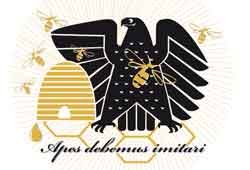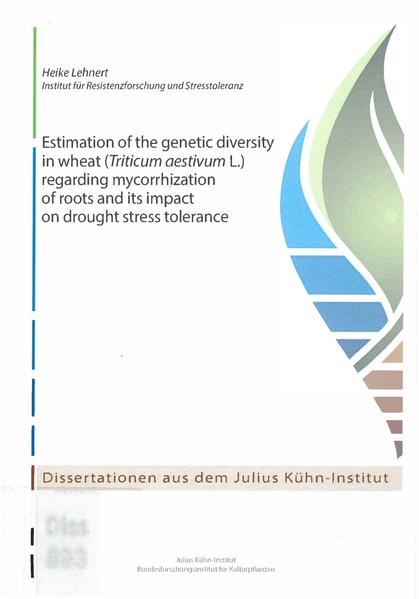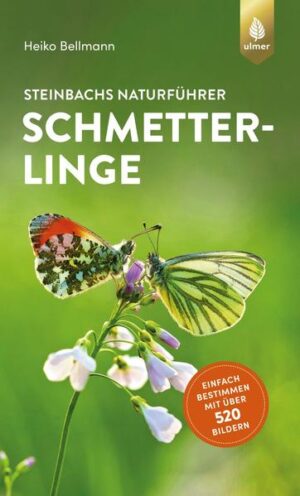- Softcover: 92 Seiten
- Verlag: Bundesforschungsinstitut für Kulturpflanzen (JKI)
- Autor: Heike Lehnert
- Auflage: 1. Aufl., erschienen am 15.01.2020
- ISBN-10: 3-95547-085-7
- ISBN-13: 978-3-95547-085-2
- Größe und/oder Gewicht: 21,0 x 14,0 cm
Estimation of the genetic diversity in wheat (Triticum aestivum L.) regarding mycorrhization of roots and its impact on drought stress tolerance
Autoren: Heike Lehnert12,95 €

HONIGHÄUSCHEN (BONN) – Bread wheat is one of the major staple food crops worldwide, which is increasing constantly in demand due to the earth’s growing population. Besides this, in the majority of wheat growing areas worldwide, the incidence of drought stress has increased significantly resulting in a negative impact on plant development and grain yield. Arbuscular mycorrhizal symbiosis are associations between specialized soil fungi and plants. The positive effects of arbuscular mycorrhizal symbiosis on plant performance under drought stress conditions by improving drought stress tolerance are widely known. Nevertheless, no extensive knowledge associated with genotypic differences in root colonization of wheat by mycorrhizal fungi and the response of wheat to mycorhizae under drought stress conditions is available. Furthermore, quantitative trait loci (QTL) involved in root colonization of wheat by mycorrhizal fungi and in the response to drought stress conditions in the presence of mycorrhizae are largely unknown. Therefore, a diverse set consisting of94 bread wheat genotypes was phenotyped under drought stress and well watered conditions in the presence and absence of mycorrhizae. Root colonization by mycorrhizal fungi, grain yield and yield components, drought stress related traits as well as response to mycorrhizae were assessed. Significant genotypic differences (p<0.000 I) were detected in root colonization of wheat by mycorrhizal fungi . Drought stress tolerance of wheat was significantly increased in the presence of mycorrh izae compared to drought stress tolerance in the absence of mycorrhizae. However, genotypes differed in their response to mycorrhizae under drought stress conditions. Interestingly, root colonization by mycorrhizal fungi and response to mycorrhizae under drought stress conditions were not correlated, indicating that both traits are independent and under control of different genomic regions. In parallel to phenotyping, wheat accessions were genotyped by using the 90K iSelect chip, resulting in a set of polymorphic single nucleotide polymorphism (SNP) markers. At the beginning of the work, no reference sequence of wheat was available. Therefore, the set ofSNP markers was mapped based on the 90K consensus map, resulting in 17,823 polymorphic mapped markers, which were used for genome-wide association studies. In total, six QTL regions associated with root colonization by mycorrhizal fungi were detected on chromosomes 3A, 4A and 7A. Since the wheat reference sequence of Chinese Spring is available, all further genome-wide association studies were conducted by using a set of 15,511 markers mapped against the reference sequence. Several QTL regions on different chromosomes were detected associated with grain yield and yield components under drought stress conditions. Furthermore, two genomic regions on chromosomes 3D and 7D were found to be significantly associated with the response to mycorrhizae under drought stress conditions. Overall, the results reveal that inoculation of wheat with mycorrhizal fungi significantly improves drought stress tolerance and that QTL regions associated with root colonization of wheat by mycorrhizal fungi and the response to mycorrhizae under drought stress conditions exist, which are independently. The results reported here provide key insight into the genetics of root colonization by mycorrhizal fungi and the response to mycorrhizae under drought stress conditions in wheat. Maybe in the future, these initial results will help to contribute to use mycorrhizal fungi effectively in bread wheat production and combine new approaches i.e. use of genotypic variation in response to mycorrhizae under drought stress conditions with existing breeding programs for drought tolerance to develop new drought stress tolerant genotypes.
Über „Estimation of the genetic diversity in wheat (Triticum aestivum L.) regarding mycorrhization of roots and its impact on drought stress tolerance“
Das vorliegende Sachbuch zu Themen aus Umwelt und Natur „Estimation of the genetic diversity in wheat (Triticum aestivum L.) regarding mycorrhization of roots and its impact on drought stress tolerance“ wurde erarbeitet und verfasst von Heike Lehnert. Dieses Sachbuch erschien am 15.01.2020 und wurde herausgegeben von Bundesforschungsinstitut für Kulturpflanzen (JKI).
Bücher wie „Estimation of the genetic diversity in wheat (Triticum aestivum L.) regarding mycorrhization of roots and its impact on drought stress tolerance“ sind im Onlineshop des Honighäuschens bestellbar. Online bestellte Fachbücher zur Imkerei und zu anderen Themen der Umwelt und des Artenschutzes sind zu den üblichen Öffnungszeiten auch direkt im Buchladen Bundesamt für magische Wesen in Bonn, der Stauhauptstadt von Nordrhein-Westfalen abholbar und werden auf Wunsch verschickt.
Das Thema Bienensterben, Rückgang von Insekten und allgemeines Artensterben ist in aller Munde und das Honighäuschen als frühere Bioland Imkerei hat sich von Anfang an daran beteiligt. Mehr als 35 Jahre Imkereierfahrung nahmen ihren Anfang 1982 mit den ersten eigenen Bienen.

Der zehnjährige Junge, der 1977 einem Hamburger Imker über die Schulter schaute; der Fünfzehnjährige, der mit der Imkerei in Zeiten begann, in denen es noch keine Varroamilbe gab; der achtzehnjährige Fahrschüler, der lernte, dass man die Windschutzsscheibe seines Autos nach einer längeren Fahrt von Insekten säubern muß; der zwanzigjährige Student, der für seine Bienen einen Platz in Bonn suchte; der dreißigjährige Berufsimker, der seinen Bienen quasi eine Gutenachtgeschichte erzählte und sich den Kopf zerbrach, wie man die Umwelt mit ihren Bienen, Wespen, Schmetterlingen und andere blütenbesuchenden Insekten vor den Machenschaften der Agrargiftindustrie und der Gleichgültigkeit agrarindustriehöriger Politiker schützt; der Imker, der nicht nur auf dem Weihnachtsmarkt Bonn die Öffentlichkeit suchte, um bei Führungen an den Bienen auf dem Dach der Bundeskunsthalle zu erleben, dass Kinder (und deren Helikoptermuttis!) Angst vor Schmetterlingen hatten, bis hin zum Begleiter von Forschungsprojekten zu den Riesenhonigbienen Nepals oder den Killerbienen Afrikas, stellt fest, dass etwas sehr im Argen liegt in unserem Umgang mit der Umwelt.
Es sollte jedem bewußt sein, dass die Haltung „Natur ja, aber bitte woanders!“ nicht in Ordnung ist.
Die wunderschöne Welt der Natur

In unserem Online-Buchshop finden Sie viele Bücher wie „Estimation of the genetic diversity in wheat (Triticum aestivum L.) regarding mycorrhization of roots and its impact on drought stress tolerance“, die Ihnen die fantastische Welt der Bienen, Wespen, Ameisen, Hornissen und Schmetterlinge sowie anderer Insekten näherbringen.
Aber nach wie vor stehe ich Ihnen auch gern zu einem Gespräch oder zu einer Beratung im Umgang mit Bienen, Wespen, Hornisse, Wildbienen und Hummeln zur Verfügung, wenn Sie Fragen haben. Besuchen Sie uns in Bonn im Bundesamt für magische Wesen.
Und natürlich gibt es auch weiterhin Honig, Bienenwachskerzen und Met bei uns und zwar das ganze Jahr – nicht nur zu Weihnachten.
| Gewicht | 200 g |
|---|---|
| Größe | 21 × 14 cm |
Marke
Bundesforschungsinstitut für Kulturpflanzen (JKI)
Nur angemeldete Kunden, die dieses Produkt gekauft haben, dürfen eine Bewertung abgeben.





Bewertungen
There are no reviews yet